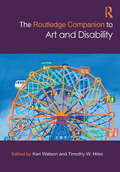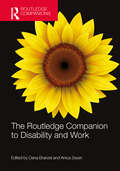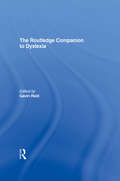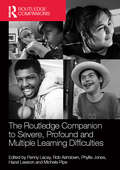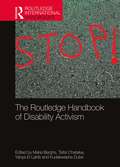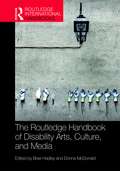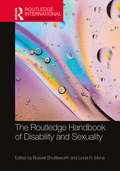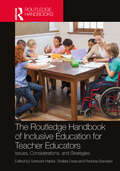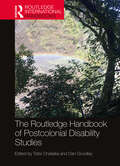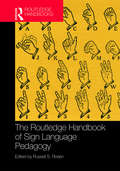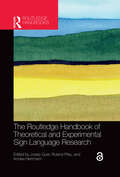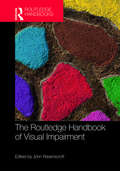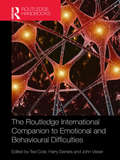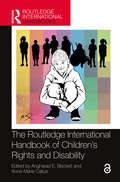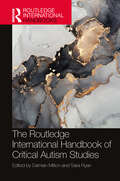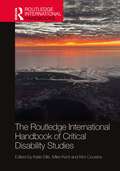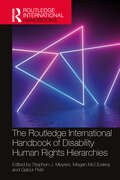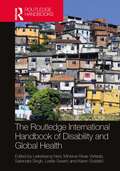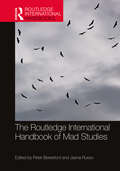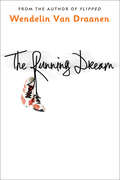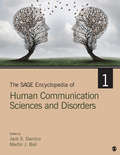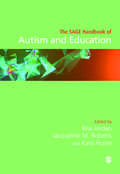- Table View
- List View
The Routledge Companion to Art and Disability (Routledge Art History and Visual Studies Companions)
by Keri Watson Timothy W. HilesThe Routledge Companion to Art and Disability explores disability in visual culture to uncover the ways in which bodily and cognitive differences are articulated physically and theoretically, and to demonstrate the ways in which disability is culturally constructed. This companion is organized thematically and includes artists from across historical periods and cultures in order to demonstrate the ways in which disability is historically and culturally contingent. The book engages with questions such as: How are people with disabilities represented in art? How are notions of disability articulated in relation to ideas of normality, hybridity, and anomaly? How do artists use visual culture to affirm or subvert notions of the normative body? Contributors consider the changing role of disability in visual culture, the place of representations in society, and the ways in which disability studies engages with and critiques intersectional notions of gender, race, ethnicity, class, and sexuality. This book will be particularly useful for scholars in art history, disability studies, visual culture, and museum studies.
The Routledge Companion to Art and Disability (Routledge Art History and Visual Studies Companions)
by Keri Watson Timothy W. HilesThe Routledge Companion to Art and Disability explores disability in visual culture to uncover the ways in which bodily and cognitive differences are articulated physically and theoretically, and to demonstrate the ways in which disability is culturally constructed. This companion is organized thematically and includes artists from across historical periods and cultures in order to demonstrate the ways in which disability is historically and culturally contingent. The book engages with questions such as: How are people with disabilities represented in art? How are notions of disability articulated in relation to ideas of normality, hybridity, and anomaly? How do artists use visual culture to affirm or subvert notions of the normative body? Contributors consider the changing role of disability in visual culture, the place of representations in society, and the ways in which disability studies engages with and critiques intersectional notions of gender, race, ethnicity, class, and sexuality.This book will be particularly useful for scholars in art history, disability studies, visual culture, and museum studies.
The Routledge Companion to Disability and Work (Routledge Companions in Business, Management and Marketing)
by Oana Branzei Anica ZeyenThe Routledge Companion to Disability and Work explores the realities faced by disabled individuals in the workplace and beyond. Despite enduring stereotypes and prejudice, disabled employees and entrepreneurs continue to achieve and thrive. This Companion documents the history and future of disability organizing, highlighting concerns of the world's largest minority—over 1 billion people or 15% of the global population. Inspired by the sunflower symbol for invisible disabilities, this Companion sheds light on the unseen efforts undertaken by disabled people to combat ableism. It delves into stories of employment, entrepreneurship, self-advocacy, activism, and well-being management. Highlighting how disabled workers mobilize support, fight for human rights, respect, and equality, navigate the challenges of disclosure and intersectionality, build networks, and foster inclusive environments, it underscores the contributions of disabled individuals and their allies. Authored by experts, many with personal experiences of disability, this Companion showcases the diverse types of work disabled people—and their allies—perform that go beyond the duties of their job roles. It provides a robust foundation for understanding and advancing disability inclusion. With global research, the Companion broadens our understanding of the (in)visible challenges and triumphs of disabled people at work. Celebrating disability pride and joy, it offers insights into navigating biases, stigma, and discrimination. The disability movement, fueled by inequities in healthcare, education, accessibility, and work, deserves attention from business leaders. This comprehensive guide is essential for students, teachers, and researchers looking to intersect disability and business, paving the way for a more inclusive and equitable future.
The Routledge Companion to Dyslexia
by Gavin ReidThe Routledge Companion to Dyslexia is a ground-breaking analysis of the whole field of dyslexia by a distinguished team of international contributors and editors, engaged in literacy, inclusion and learning. Their diverse perspectives and wide expertise make this invaluable guide one of the most important additions to the field of dyslexia for over a decade. Dyslexia is without doubt the most high profile and contentious learning difficulty, and it is a topic that has attracted a vast amount of research, opinion, professional schisms, and debate. The Companion provides an invaluable overview of the field of dyslexia with vital and clear emphasis on linking theoretical perspectives with best practice. This accessible text: presents a survey of current and future development in research, with a focus on how research can inform practice focuses on areas such as neurobiology, phonological processing, literacy acquisition, numeracy and multilingualism considers assessment and identification, with contributions on early identification, reading, spelling and mathematics addresses identifying and meeting needs in an inclusive context discusses inclusion and barriers to learning in a variety of different national contexts includes models of instruction, direct instruction, co-operative learning and cross-curricular learning. The Routledge Companion to Dyslexia is a superb resource for anyone interested in the subject, whether in education or related subjects such as psychology or neurology. Fully indexed and cross-referenced, with helpful further reading sections at the end of each entry, it is ideal for those coming to the field of dyslexia for the first time as well as students and practitioners already familiar with the subject.
The Routledge Companion to Severe, Profound and Multiple Learning Difficulties
by Penny Lacey Phyllis Jones Rob Ashdown Hazel Lawson Michele PipeThe Routledge Companion to Severe, Profound and Multiple Learning Difficulties is a timely and rich resource with contributions from writing teams of acknowledged experts providing a balance of both academic and practitioner perspectives. The book covers a myriad of topics and themes and has the core purpose of informing and supporting everyone who is interested in improving the quality of education and support for children and young adults with severe, profound and multiple learning difficulties and their families. Each chapter contains careful presentations and analyses of the findings from influential research and its practical applications and the book is a treasure chest of experiences, suggestions and ideas from practitioners that will be invaluable for many years to come. The chapters include many vignettes gathered from practitioners in the field and are written specifically to be rigorous yet accessible. The contributors cover topics related to the rights and needs of children and young adults from 0-25 years, crucial features of high quality education, characteristics of integrated provision and effective and sensitive working with families to ensure the best possible outcomes for their children. Crucially, the voice of the learners themselves shines through. Historical provision that has had an impact on developing services and modern legislation aimed at improving provision and services are also discussed. The contributed chapters are organised into six themed parts: Provision for learners with SLD/PMLD. Involving stakeholders. Priorities for meeting the personal and social needs of learners. Developing the curriculum. Strategies for supporting teaching and learning. Towards a new understanding of education for learners with SLD/PMLD. This text is an essential read for students on courses and staff working in and with the whole range of educational settings catering for children and young adults with severe, profound and multiple learning difficulties, not just for teachers but also for support staff, speech and language therapists, physiotherapists, psychologists, nurses, social workers and other specialists.
The Routledge Handbook of Disability Activism (Routledge International Handbooks)
by Maria Berghs Tsitsi Chaitaka Yayha El-Lahib Andrew DubeThe onslaught of neoliberalism, austerity measures and cuts, impact of climate change, protracted conflicts and ongoing refugee crisis, rise of far right and populist movements have all negatively impacted on disability. Yet, disabled people and their allies are fighting back and we urgently need to understand how, where and what they are doing, what they feel their challenges are and what their future needs will be. This comprehensive handbook emphasizes the importance of everyday disability activism and how activists across the world bring together a wide range of activism tactics and strategies. It also challenges the activist movements, transnational and emancipatory politics, as well as providing future directions for disability activism. With contributions from senior and emerging disability activists, academics, students and practitioners from around the globe, this handbook covers the following broad themes: • Contextualising disability activism in global activism • Neoliberalism and austerity in the global North • Rights, embodied resistance and disability activism • Belonging, identity and values: how to create diverse coalitions for rights • Reclaiming social positions, places and spaces • Social media, support and activism • Campus activism in higher education • Inclusive pedagogies, evidence and activist practices • Enabling human rights and policy • Challenges facing disability activism The Routledge Handbook of Disability Activism provides disability activists, students, academics, practitioners, development partners and policy makers with an authoritative framework for disability activism.
The Routledge Handbook of Disability Arts, Culture, and Media
by Bree Hadley Donna McDonaldIn the last 30 years, a distinctive intersection between disability studies – including disability rights advocacy, disability rights activism, and disability law – and disability arts, culture, and media studies has developed. The two fields have worked in tandem to offer critique of representations of disability in dominant cultural systems, institutions, discourses, and architecture, and develop provocative new representations of what it means to be disabled. Divided into 5 sections: Disability, Identity, and Representation Inclusion, Wellbeing, and Whole-of-life Experience Access, Artistry, and Audiences Practices, Politics and the Public Sphere Activism, Adaptation, and Alternative Futures this handbook brings disability arts, disability culture, and disability media studies – traditionally treated separately in publications in the field to date – together for the first time. It provides scholars, graduate students, upper level undergraduate students, and others interested in the disability rights agenda with a broad-based, practical and accessible introduction to key debates in the field of disability art, culture, and media studies. An internationally recognised selection of authors from around the world come together to articulate the theories, issues, interests, and practices that have come to define the field. Most critically, this book includes commentaries that forecast the pressing present and future concerns for the field as scholars, advocates, activists, and artists work to make a more inclusive society a reality.
The Routledge Handbook of Disability and Sexuality (Routledge International Handbooks)
by Russell Shuttleworth and Linda R. MonaThis handbook provides a much-needed holistic overview of disability and sexuality research and scholarship. With authors from a wide range of disciplines and representing a diversity of nationalities, it provides a multi-perspectival view that fully captures the diversity of issues and outlooks. Organised into six parts, the contributors explore long-standing issues such as the psychological, interpersonal, social, political and cultural barriers to sexual access that disabled people face and their struggle for sexual rights and participation. The volume also engages issues that have been on the periphery of the discourse, such as sexual accommodations and support aimed at facilitating disabled people's sexual well-being; the socio-sexual tensions confronting disabled people with intersecting stigmatised identities such as LGBTBI or asexual; and the sexual concerns of disabled people in the Global South. It interrogates disability and sexuality from diverse perspectives, from more traditional psychological and sociological models, to various subversive and post-theoretical perspectives and queer theory. This handbook examines the cutting-edge, and sometimes ethically contentious, concerns that have been repressed in the field. With current, international and comprehensive content, this book is essential reading for students, academics and researchers in the areas of disability, gender and sexuality, as well as applied disciplines such as healthcare practitioners, counsellors, psychology trainees and social workers.
The Routledge Handbook of Inclusive Education for Teacher Educators: Issues, Considerations, and Strategies
by Santoshi Halder, Shakila Dada and Rashida BanerjeeThis handbook provides foundational, conceptual, and practical knowledge and understanding of inclusive education and special needs education. It highlights the need for preparing special educators and teachers for inclusive classrooms to effectively cater to the needs of students with diverse needs in various low-, middle-, and high-income countries globally. It demonstrates various evidence-based and practice-based strategies required to create classrooms inclusive of diverse learners. While tracing the historical trajectory of the foundational underpinnings, philosophical bases, and crucial issues associated with inclusive education, this book presents a future roadmap and pathways through case instances and in-depth discussions to share with educators how they can strengthen their bases and make learning more inclusive in their context. It also provides an overview of the different models of assessment and their applications in the analysis of children in inclusive classroom settings. Comprehensive, accessible, and nuanced, this handbook will be of immense interest and benefit to teachers, educators, special educators, students, scholars, and researchers in the areas of social inclusion, education, special needs education, educational psychology, technology for inclusion, disability studies, among other related disciplines. It will be extremely beneficial for academicians, teacher educators, special educators, and those interested in professional teacher training courses.
The Routledge Handbook of Postcolonial Disability Studies (Routledge International Handbooks)
by Dan Goodley Tsitsi ChataikaThis book centres and explores postcolonial theory, which looks at issues of power, economics, politics, religion and culture and how these elements work in relation to colonial supremacy. It argues that disability is a constitutive material presence in many postcolonial societies and that progressive disability politics arise from postcolonial concerns. By drawing these two subjects together, this handbook challenges oppression, voicelessness, stereotyping, undermining, neo-colonisation and postcolonisation and bridges binary debate between global North and the global South.The book is divided into eight sectionsi Setting the Sceneii Decolonising Disability Studiesiii Postcolonial Theory, Inclusive Developmentiv Postcolonial Disability Studies and Disability Activismv Postcolonial Disability and Childhood Studiesvi Postcolonial Disability Studies and Educationvii Postcolonial Disability Studies, Gender, Race and Religionviii ConclusionAnd comprised of 27 newly written chapters, this book leads with postcolonial perspectives – closely followed by an engagement with critical disability studies – with the explicit aim of foregrounding these contributions; pulling them in from the edges of empirical and theoretical work where they often reside in mainstream academic literature.The book will be of interest to all scholars and students of disability studies and postcolonial studies as well as those working in sociology, literature and development studies.
The Routledge Handbook of Sign Language Pedagogy (Routledge Language Handbooks)
by Russell S. RosenThe Routledge Handbook of Sign Language Pedagogy is the first reference of its kind, presenting contributions from leading experts in the field of sign language pedagogy. The Handbook fills a significant gap in the growing field of sign language pedagogy, compiling all essential aspects of current trends and empirical research in teaching, curricular design, and assessment in one volume. Each chapter includes historical perspectives, core issues, research approaches, key findings, pedagogical implications, future research direction, and additional references. The Routledge Handbook of Sign Language Pedagogy is an essential reference for sign language teachers, practitioners, and researchers in applied sign linguistics and first, second, and additional language learning.
The Routledge Handbook of Theoretical and Experimental Sign Language Research (Routledge Handbooks in Linguistics)
by Josep QuerThe Routledge Handbook of Theoretical and Experimental Sign Language Research bridges the divide between theoretical and experimental approaches to provide an up-to-date survey of key topics in sign language research. With 29 chapters written by leading and emerging scholars from around the world, this Handbook covers the following key areas: On the theoretical side, all crucial aspects of sign language grammar studied within formal frameworks such as Generative Grammar; On the experimental side, theoretical accounts are supplemented by experimental evidence gained in psycho- and neurolinguistic studies; On the descriptive side, the main phenomena addressed in the reviewed scholarship are summarized in a way that is accessible to readers without previous knowledge of sign languages. Each chapter features an introduction, an overview of existing research, and a critical assessment of hypotheses and findings. The Routledge Handbook of Theoretical and Experimental Sign Language Research is key reading for all advanced students and researchers working at the intersection of sign language research, linguistics, psycholinguistics, and neurolinguistics.
The Routledge Handbook of Visual Impairment: Social and Cultural Research (Routledge International Handbooks)
by John RavenscroftThe Routledge Handbook of Visual Impairment examines current debates as well as cross-examining traditionally held beliefs around visual impairment. It provides a bridge between medical practice and social and cultural research drawing on authentic investigations. It is the intention of this Handbook to provide an opportunity to engage with academic researchers who wish to ensure a coherent and rigorous approach to research construction and reflection on visual impairment that is in collaboration with, but sometimes is beyond, the medical realm. This Handbook is divided into ten thematic areas in order to represent the wide range of debates and concepts within visual impairment. The ten themes include: cerebral visual impairment; education; sport and physical exercise; assistive technology; understanding the cultural aesthetics; socio-emotional and sexual aspects of visual impairment; orientation, mobility, habitation, and rehabilitation; recent advances in "eye" research and sensory substitution devices; ageing and adulthood. The 27 chapters that explore the social and cultural aspects of visual impairment can be taken and used in a variety of different ways in order to promote research and generate debate among practitioners and scholars who wish to use this resource to inform their practice in supporting and developing positive outcomes for all.
The Routledge International Companion to Emotional and Behavioural Difficulties
by Harry Daniels Ted Cole John VisserResponding to disruptive or troubled pupils with emotional and behavioural difficulties (EBD) remains a highly topical issue. The challenges these children present relate to wider issues of continuing political concern: the perceived declining discipline in schools; school and social exclusion; the limits to inclusion for children with special needs; increasing mental health difficulties in children; youth crime and parenting skills. It’s little wonder that the 'EBD' (often known as ‘BESD’ or ‘SEBD’) category is one of the most common forms of SEN around the world. This topical and exhaustively-researched Companion examines the difficulties of defining EBD, and the dangers of allocating this imprecise label to children. Bringing together the work of contributors from fifteen countries and across four continents, this book features the research of leading experts in the global field of EBD, who discuss and debate educators’ key concerns by: looking at the overlaps between EBD, ADHD and mental health difficulties; outlining the types of appropriate schooling for children with EBD; urging readers to look beyond pupils’ challenging behaviour in order to understand and respond to the social, biological and psychological causation; considering the key areas of assessment, whole-school and targeted approaches that help pupils with EBD in mainstream and in special settings; outlining helpful work with families, the crucial contribution of effective multi-agency working and the importance of supporting and developing teachers who work with challenging pupils. Containing contrasting views on controversial topics, this Companion’s approachable style makes it an essential reference book for academics, policy makers, practitioners, educators and students who are working towards a higher degree in education.
The Routledge International Handbook of Children's Rights and Disability (Routledge International Handbooks)
by Angharad E. Beckett Anne-Marie CallusThis handbook provides authoritative and cutting-edge analyses of various aspects of the rights and lives of disabled children around the world. Taking the UN Convention on the Rights of Persons with Disabilities (CRPD) and the UN Convention of the Rights of the Child (CRC) as conceptual frameworks, this work appraises the current state of affairs concerning the rights of disabled children across different stages of childhood, different life domains, and different socio-cultural contexts. The book is divided into four sections: Legislation and Policy Children’s Voice The Life Course in Childhood Life Domains in Childhood Comprised of 37 newly commissioned chapters featuring analyses of UN documents and case studies from Australia, Brazil, Ethiopia, Hong Kong, Italy, the Netherlands, Norway, Papua New Guinea, Serbia, South Africa, Spain, Sweden, the United Kingdom, the United States, and Vanuatu, its multidisciplinary approach reflects the complexities of the lives of disabled children and the multifarious nature of the strategies needed to ensure their rights are upheld. It will be of interest to researchers and students working in disability studies, education, allied health, law, philosophy, play studies, social policy, and the sociology of childhood. It will also be a valuable resource for professionals/practitioners, allowing them to consider future directions for ensuring that disabled children’s rights are realised and their well-being and dignity are assured.
The Routledge International Handbook of Critical Autism Studies (Routledge International Handbooks)
by Damian Milton and Sara RyanThis handbook provides an authoritative and up-to-date overview of Critical Autism Studies and explores the different kinds of knowledges and their articulations, similarities, and differences across cultural contexts and key tensions within this subdiscipline. Critical Autism Studies is a developing area occupying an exciting space of development within learning and teaching in higher education. It has a strong trajectory within the autistic academic and advocate community in resistance and response to the persistence of autism retaining an identity as a genetic disorder of the brain. Divided into four parts • Conceptualising autism • Autistic identity • Community and culture • Practice and comprising 24 newly commissioned chapters written by academics and activists, it explores areas of education, Critical Race Theory, domestic violence and abuse, sexuality, biopolitics, health, and social care practices. It will be of interest to all scholars and students of disability studies, sociology, anthropology, cultural studies, education, health, social care, and political science.
The Routledge International Handbook of Critical Disability Studies (Routledge International Handbooks)
by David T. Mitchell Tanya Titchkosky Alex Lubet David J. Connor Beth A. Ferri David Bolt Najma Al Zidjaly Katie Ellis Mike Kent Gerard Goggin Lorna Piatti-Farnell Bree Hadley Eddie Paterson Dale Jacobs Amy Shields Dobson Subini Ancy Annamma Anna Hickey-Moody Amber E. George Jay Dolmage Beth Haller Janice Rieger Stephanie Mantilla Kim Cousins Saadia Ahmed Natarsha Bates Emily Brooks Elaine Cagulada Philip Ely Matheus Ferreira Jordan Alice Fyfe Divya Garg Dan Graham Hersinta Tatiane Hilgemberg Suzanne Ingelbrecht Kai-Ti Kao Karin Ljuslinder Kathryn Locke Jennifer McKellar Cátia Malaquias Tim Pitman Chloe T. Rattray Jennifer Smith-Merry Sian Tomkinson Lotta Vikström Josefine Wälivaara Nathon Webber Cassandra Wright-Dole Kuansong Victor ZhuangDisability impacts everyone in some way. Approximately 10-20% of the world’s population live with disability, and the associated issues affect not just these individuals but also their friends, family, and colleagues. When looking at it this way, it is strange that disability continues to be thought of as an anomaly—either as a medical problem located in a damaged body or something that exists exclusively outside the body, in a society that takes little account of non-normative bodies.Critical disability studies both questions these existing notions of disability and interrogates how they have become a part of the academic attitude towards the field. As the first comprehensive handbook on critical disability studies, this volume provides an authoritative overview of the subject. Including 32 chapters written by established scholars and emerging, next-generation researchers it also includes contributions from activists, writers, and practitioners from the global north and the global south.Divided into three parts: Representation, art, and culture; Media, technology, and communication; and Activism and the life course, it offers discussions on core critical disability studies topics including the social model, technology studies, trauma studies, representation, and queer theory, as well as ground-breaking work on emerging and cutting-edge areas such as neurodiversity and critical approaches in the Middle East, United States, Australia, and Europe.It is required reading for all academics and students working in not just critical disability studies but sociology, digital accessibility and inclusion, health and social care, and social and public policy more broadly.
The Routledge International Handbook of Disability Human Rights Hierarchies (Routledge International Handbooks)
by Stephen J. Meyers Megan McCloskey Gabor PetriDisability is defined by hierarchy. Regardless of culture or context, persons with disabilities are almost always pushed to the bottom of the social hierarchy. With the advent of the Convention on the Rights of Persons with Disabilities (2006), disability human rights seemingly provided a path forward for tearing down ableist social hierarchies and ensuring that all persons with disabilities everywhere were treated equally. Despite important progress, the disability human rights project not only remains incomplete, but has often created new hierarchies among persons with disabilities themselves or across the human rights it promotes. Certain groups of persons with disabilities have gained new voices while others remain silenced and certain rights are prioritized over others depending on what states, international organizations, or advocates want rather than what those on the ground need most. This volume was inspired both by the continued need to expose human rights violations against persons with disabilities, but to also explore the nuanced role that hierarchies play in the spread, implementation, and protection of disability human rights. The enjoyment of human rights is not equal nor is the recognition of specific individuals and groups’ rights. In order to change this situation, inequalities across the disability human rights movement must be explored. Divided into five parts: Who counts as disabled? Political, social, and cultural context Which rights on top, whose rights on bottom? Pushed to the periphery in the disability rights movement Representations of disability and comprised of 34 newly-written chapters including case-studies from the Anglophone Caribbean, Bangladesh, Bosnia-Herzegovina, China, Ghana, Haiti, Hungary, India, Israel, Kenya, Latin America, Poland, Russia, Scotland, Serbia and South Africa, and other countries, this book will be of interest to all scholars and students of disability studies, sociology, human rights law and social policy.
The Routledge International Handbook of Disability and Global Health (Routledge International Handbooks)
by Leslie Swartz Karen Soldatić Lieketseng Ned Minerva Rivas Velarde Satendra SinghThis handbook will raise awareness about the importance of health and well-being of people with disabilities in the context of the global development agenda: Leaving No-one Behind.There has been a growing discussion on how people with disabilities should be included in the global health landscape. An estimated one billion people have some form of disability, 80% of whom live in low- and middle-income settings. People with disabilities are more likely to be poor, with restricted access to health and social services, education, rehabilitation and employment. Despite this, people with disabilities are often overlooked in global health and development efforts. Furthermore, the COVID-19 pandemic has shown that unless systematically planned for and included in policies and programmes, people with disabilities remain at an increased risk of being adversely affected in times of humanitarian crisis and emergency disasters.Divided into eight sections: Disability and Health Frameworks Health Justice, Rights and Bioethics Gendering Disability Health Disability and Global Mental Health Disability and Access to Healthcare, Including Workforce Development Crises and Health Technology and Digital Health Disability, Ageing and Dementia Care This handbook covers the full range of topics pertaining to disability and global health including inclusive health; access to rehabilitation; global mental health and disability; medical training and disability; community based inclusive development for improving health and rehabilitation; maternal health and sexual reproduction; preventive care and health promotion for people with disabilities; health, disability and indigenous knowledges; bioethics and human rights; data protection; and health in the global south.It will be of interest to all scholars, students and professionals working in the fields of disability studies, health studies, nursing, medicine, allied health, development studies and sociology.
The Routledge International Handbook of Mad Studies (Routledge International Handbooks)
by Peter BeresfordBy drawing broadly on international thinking and experience, this book offers a critical exploration of Mad Studies and advances its theory and practice. Comprised of 34 chapters written by international leading experts, activists and academics, this handbook introduces and advances Mad Studies, as well as exploring resistance and criticism, and clarifying its history, ideas, what it is, and what it can offer. It presents examples of mad studies in action, covering initiatives that have been taken, their achievements and what can be learned from them. In addition to sharing research findings and evidence, the book offers examples and insights for advancing understandings of experiences of madness and distress from the perspectives of those who have (had) those experiences, and also explores ways of supporting people oppressed by conventional understandings and systems. This book will be of interest to all scholars and students of Mad Studies, disability studies, sociology, socio- legal studies, mental health and medicine more generally.
The Running Dream
by Wendelin Van DraanenThe acclaimed author of Flipped delivers a powerful and healing story that&’s perfect for anyone who&’s ever thought that something was impossible. Readers will revel in the story of a girl who puts herself back together—and learns to dream bigger than ever before—after she&’s told she&’ll never run again. Jessica thinks her life is over when she loses a leg in a car accident. She's not comforted by the news that she'll be able to walk with the help of a prosthetic leg. Who cares about walking when you live to run?As she struggles to cope with crutches and a first cyborg-like prosthetic, Jessica feels oddly both in the spotlight and invisible. People who don't know what to say, act like she's not there. Which she could handle better if she weren't now keenly aware that she'd done the same thing herself to a girl with CP named Rosa. A girl who is going to tutor her through all the math she's missed. A girl who sees right into the heart of her.With the support of family, friends, a coach, and her track teammates, Jessica may actually be able to run again. But that's not enough for her now. She doesn't just want to cross finish lines herself—she wants to take Rosa with herWinner of the Schneider Family Book Award
The SAGE Encyclopedia of Human Communication Sciences and Disorders
by Dr Jack S. Damico Professor Martin J. BallThe SAGE Encyclopedia of Human Communication Sciences and Disorders is an in-depth encyclopedia aimed at students interested in interdisciplinary perspectives on human communication—both normal and disordered—across the lifespan. This timely and unique set will look at the spectrum of communication disorders, from causation and prevention to testing and assessment; through rehabilitation, intervention, and education. Examples of the interdisciplinary reach of this encyclopedia: A strong focus on health issues, with topics such as Asperger's syndrome, fetal alcohol syndrome, anatomy of the human larynx, dementia, etc. Including core psychology and cognitive sciences topics, such as social development, stigma, language acquisition, self-help groups, memory, depression, memory, Behaviorism, and cognitive development Education is covered in topics such as cooperative learning, special education, classroom-based service delivery The editors have recruited top researchers and clinicians across multiple fields to contribute to approximately 640 signed entries across four volumes.
The SAGE Encyclopedia of Human Communication Sciences and Disorders
by Dr Jack S. Damico Professor Martin J. BallThe SAGE Encyclopedia of Human Communication Sciences and Disorders is an in-depth encyclopedia aimed at students interested in interdisciplinary perspectives on human communication—both normal and disordered—across the lifespan. This timely and unique set will look at the spectrum of communication disorders, from causation and prevention to testing and assessment; through rehabilitation, intervention, and education. Examples of the interdisciplinary reach of this encyclopedia: A strong focus on health issues, with topics such as Asperger's syndrome, fetal alcohol syndrome, anatomy of the human larynx, dementia, etc. Including core psychology and cognitive sciences topics, such as social development, stigma, language acquisition, self-help groups, memory, depression, memory, Behaviorism, and cognitive development Education is covered in topics such as cooperative learning, special education, classroom-based service delivery The editors have recruited top researchers and clinicians across multiple fields to contribute to approximately 640 signed entries across four volumes.
The SAGE Handbook of Autism and Education
by Rita Jordan Jacqueline M. Roberts Kara HumeEducation is an important aspect of the environmental influences on autism and effective education can have a significant effect on outcome for those on the autism spectrum. This handbook is a definitive resource for reflective practitioners and researchers who wish to know and understand current views of the nature of autism and best practice in educational support. It explores the key concepts, debates and research areas in the field.
The SAGE Handbook of Autism and Education
by Rita Jordan Jacqueline M. Roberts Kara HumeEducation is an important aspect of the environmental influences on autism and effective education can have a significant effect on outcome for those on the autism spectrum. This handbook is a definitive resource for reflective practitioners and researchers who wish to know and understand current views of the nature of autism and best practice in educational support. It explores the key concepts, debates and research areas in the field.
